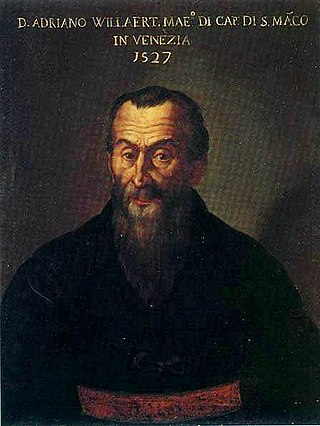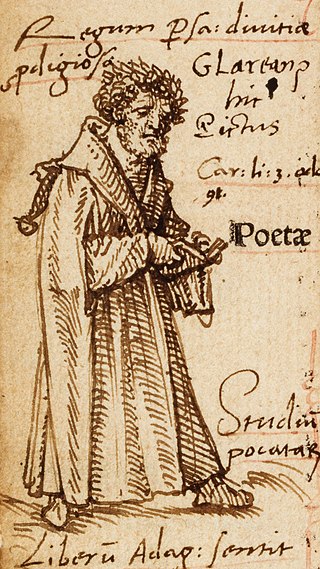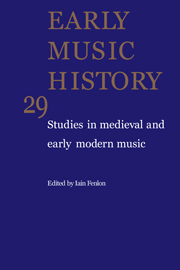Year 1486 (MCDLXXXVI) was a common year starting on Sunday.

Adrian Willaert was a Flemish composer of High Renaissance music. Mainly active in Italy, he was the founder of the Venetian School. He was one of the most representative members of the generation of northern composers who moved to Italy and transplanted the polyphonic Franco-Flemish style there.

Heinrich Glarean also styled Henricus Glareanus was a Swiss music theorist, poet and humanist. He was born in Mollis and died in Freiburg im Breisgau.
Alessandro Striggio was an Italian composer, instrumentalist and diplomat of the Renaissance. He composed numerous madrigals as well as dramatic music, and by combining the two, became the inventor of madrigal comedy. His son, also named Alessandro Striggio, wrote the libretto for Monteverdi's Orfeo.

Bernardo Clesio was an Italian Cardinal, bishop, diplomat, humanist and botanist.
The year 1696 in music involved some significant events.
Ippolito Fiorini was a composer and lutenist, and the maestro di capella at the court of Alfonso II d'Este in Ferrara during its entire existence (1568–1597). As maestro di capella his role was largely an administrative one, however in addition to being involved with the music of the chapel he also was involved with the concerto delle donne. He also played the archlute. He wrote music for the duchesses' balletti to the text of Giovanni Battista Guarini, although none is extant, and probably also wrote for the concerto delle donne. He was in charge of the Accademia della Morte in Ferrara from 1594 to 1597.
Philippus de Caserta, was a medieval music theorist and composer associated with the style known as ars subtilior.
Gioseppe Caimo was an Italian composer and organist of the Renaissance, mainly active in Milan. He was a prolific composer of madrigals and other secular vocal music, and was one of the most prominent musicians in Milan in the 1570s and early 1580s.
Tra quante regione is a ballata by the late medieval and early renaissance composer Hugo de Lantins. As with another vocal composition by Guillaume Dufay entitled Vasilissa ergo gaude, Lantins' ballata celebrated the marriage of the Italian princess Cleofa Malatesta with the Byzantine Despot of the Morea Theodore II Palaiologos. The marriage took place on 21 January 1421 or sometime in 1422 in Mystra. The actual date and place of the first performance remain disputed
Iain Alexander Fenlon is a British musicologist who specializes in music from 1450–1650; particularly Renaissance and early Baroque music from Italy.
Simone Balsamino was an Italian composer, poet and dramatist. He was the first to set texts from Tasso's Aminta as Aminta musicale. He is also credited with the invention of the bass cittern.
Jean Escatefer dit Cousin was a French or Flemish singer and composer of the Burgundian School and a member of the royal chapel from about 1461.
Egidius, sometimes Magister Egidius, is an ars subtilior composer found in the Chantilly Codex and the Modena Codex. Works attributed to "Egidius" in the Chantilly Codex comprise the ballades Roses et lis and Courtois et sage, dedicated to Pope Clement VII in Avignon. He is potentially identifiable with Egidius de Murino, a composer and music theorist active at the same time.
The University of Cambridge was the first institution in the world to award a dedicated Bachelor of Music degree. The Faculty of Music was established in 1947, and has this since grown into an academic centre covering all the aspects of study and research in music.

Girard de Beaulieu, better known by the incorrectly recorded name Lambert de Beaulieu was a French bass singer, instrumentalist, and composer. He was employed at the court of Henri III as basse singer and composer from 1559. He was associated with the Académie de Baïf, one of whose aristocratic poets, Nicolas Filleul de La Chesnaye, the king's almoner, was to provide the lyrics for the ballet Circé in the first French ballet de cour, the Balet Comique de la Royne of 1581, for which Beaulieu and Jacques Salmon provided the music. Choreography and overall direction were provided by the Italian dancing master Baltazarini, known as Balthasar de Beaujoyeulx. Sets and costumes were provided by Jacques Patin.
Francesco dalla Viola was a 16th-century choirmaster and composer.
Paolo Isnardi was a late-Renaissance choirmaster and composer.
Giovanni Matteo Faà di Bruno was an Italian nobleman, member of the Faà di Bruno family in the Casale Monferrato region. A musician of some importance in his lifetime, he composed a limited number of sacred and secular works, most notably two books of madrigals and a set of vespers. His affiliation with the ducal family of the Gonzagas is evident in the dedicatory prefaces to his books of madrigals; the first dedicated to Guglielmo Gonzaga and the second to his son and heir to the ducal throne Vincenzo.
Ludwig Daser was a German renaissance composer and choirmaster. His career is marked by the Reformation and Counter-Reformation struggles of his time. A noted composer in his day, Daser has been largely overshadowed by Orlande de Lassus, who replaced him in Munich.




